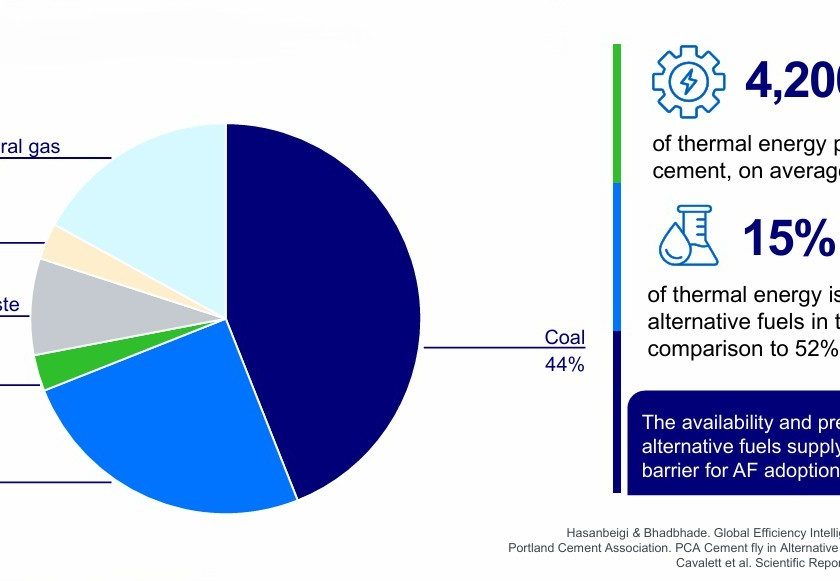The Ambitious Port-Daniel-Gascons Project Remains On Track Despite Controversy.
By Josie Smith
As reported in the Cement America’s January 2014 feature, “McInnis Cement Thinks Big,” McInnis Cement announced financing and receipt of final permits to spur 2014–2016 construction of a 2 million-2.5 million tpy plant and marine terminal in Port-Daniel-Gascons, Quebec, Canada.
of final permits to spur 2014–2016 construction of a 2 million-2.5 million tpy plant and marine terminal in Port-Daniel-Gascons, Quebec, Canada.
Anchoring an export-driven business model, the marine terminal will be equipped to load barges – bound for Great Lakes and Northeast U.S. markets – at rates up to 2,000 tph. With deep-water load out, the plant will be able to deliver material to Atlantic coast points south or St. Lawrence Seaway points west in two to three sailing days. McInnis Cement recently acquired land adjacent to the limestone-rich, 850-acre site it already owns to provide substantial backup reserves and guarantee the mill’s long-term viability.
Recently, the company announced that the financial structure of the plant was completed. National Bank of Canada confirmed the availability of a $360 million loan for the project. The announcement capped financing for the operation, led by a $500 million commitment from private and public investors, and $250 million commercial loan from province agency Investissement Québec.
“We are pleased that the project can be realized without any subsidy; we are also very proud to be able to complete, more than 30 years after it was imagined by local entrepreneurs, this visionary, ambitious and modern cement plant at the cutting edge of technology,” stated Christian Gagnon, CEO of McInnis Cement. “Construction has begun and the project is well under way. Moreover, the ecological footprint of this flagship project for the cement industry in Canada and across the world will be one of the lowest in the industry.”
Fuel Fix
The cement plant will reportedly use up to 40 percent less fuel per ton of cement than traditional cement plants (due to higher use of hydroelectric power) reducing emissions of greenhouse gas. It will be equipped with all the latest technology for improved environmental performance, including the latest generation bag filters throughout the plant for improved efficiency. The plant will also utilize maritime transportation for fuel, further reducing greenhouse gas emissions associated with the project.
Additionally, the facility will comply with the U.S. standards set out in the National Emission Standards for Hazardous Air Pollutants (NESHAP 2015), which are more stringent than those presently applied in Quebec. The Port-Daniel cement plant will be the only one in Canada to comply with the NESHAP 2015 standards.
The project will use petroleum coke as fuel, an oil refinery residue with a high heating value. The cement plant represents one of the more ecological ways of putting this residue to good use. Its kilns that operate at very high temperatures enable its usage while reducing atmospheric emissions through a succession of high performing filtration stages of the combustion gases.
“Over the coming years, we intend to reduce even further the greenhouse gas emissions (GHG) by partly replacing the petroleum coke with biomass, available in the Gaspé region. This partial conversion to biomass is at the very heart of the concept of this new cement plant,” added Gagnon.
Voluntary Release
McInnis Cement has released, on a voluntary basis, the documents related to the environmental assessment of the Port-Daniel cement plant project, although the project is not subject to the BAPE process.
The documents have been available on the McInnis Cement website since November 2013. Moreover, the monitoring committee of the project has been active since March 2013 and an information office has been opened in Port-Daniel since June 2013 to answer questions of citizens and workers wishing to learn more about the project.
“We have received at our offices people who are proud to see this major project move forward, as well as workers pleased to be part of the construction of a project that will have a significant economic impact for years to come, and that will provide quality jobs to the Gaspé region. The Port-Daniel cement plant will favorably position Quebec on the North American export market and strengthen its competitiveness in the cement industry. For years, we haven’t seen such a unique project of its type and size in all of eastern North America. We are determined to make the Port-Daniel cement plant a sustainable and profitable project for all Quebeckers,” concluded Gagnon.
Critics Are Taking Action
The construction of one of the most ambitious cement projects in North America has its critics. In July, U.S. Sen. Sherrod Brown (D-Ohio) urged the Obama administration to protect Paulding County, Ohio’s, cement industry and the thousands of local jobs it supports.
In a letter to United States Trade Representative Michael Froman, Brown called for the administration to crack down on Canada’s attempt to “illegally subsidize” the cement industry into the McInnis Cement plant, which would specifically target the U.S. market.
“Paulding County workers can compete with anyone when given a level playing field,” said Brown. “But if countries like Canada illegally subsidize their industries, and target the U.S. market, it gives their products an unfair advantage. I urge the administration to investigate the nearly $500 million subsidy package proposed for the Quebec plant, which will directly compete with Lafarge North America’s facility in Paulding. Actions must be taken in order to protect Paulding jobs and the economy of northwest Ohio.”
Lafarge Responds
John Stull, president and CEO of Lafarge North America, stated, “Lafarge North America appreciates the inquiry to the United States Trade Representative to address a serious threat to U.S. cement producers and their workers. Given the excess cement capacity in the Province of Quebec, the McInnis Cement plant makes no economic sense.
“Lafarge believes that the plant would not be built without enormous support from the federal and provincial government. Lafarge joins Senator Brown in urging the U.S. government to engage with the Canadian government regarding the provision of subsidies that appear to be prohibited by World Trade Organization rules and threaten material harm to the U.S. cement industry,” Stull said.
Furthermore, Lafarge joined two non-profit groups in mounting a legal challenge against a Quebec cabinet minister’s authorization of the McInnis Cement plant.
The company, together with the Centre Québécois du droit de l’Environnement and Environnement Vert-Plus Inc., filed a motion for judicial review asking the Quebec Superior Court to overturn a decision by David Heurtel, Quebec’s environment minister, authorizing construction of the McInnis plant.
The plaintiffs argue Heurtel “exceeded his jurisdiction” by giving the controversial project a green light in June without it being subjected to an environmental impact assessment and review. They are seeking a full environmental review to take place by the province’s Bureau d’Audiences publiques sur l’environnement (BAPE).
Heurtel states the cement project is not subject to a BAPE review because it was launched in 1995, before the law was changed to require automatic review for large-scale industrial projects. He pledged the project will be tracked rigorously.
“There is an approval process outlined in provincial legislation that all companies must follow,” Lafarge spokesman Regan Watts said in an emailed statement. “It appears as though in serving the interest of accelerating this project, the approval for these permits may have been issued in violation of the government’s own laws and potentially put the health of the environment at risk.”
The plaintiffs state the cement plant will generate an estimated 10 percent of all of Quebec’s industrial greenhouse gas emissions when it’s up and running, making an environmental review essential.
According to its legal motion, even if the promoters had filed all the required information and documents in support of their project before the law was changed, which they maintain wasn’t done, “the simple fact remains that the current project would have to be subjected to the environmental impact assessment and review procedure.”
The plaintiffs state McInnis is now pitching plans for up to 2.2 million metric tons of cement at the plant, double the original capacity. “It’s important that we shed light on the approval process of this project,” said Michel Bélanger, a Montreal lawyer representing the non-profits in the case. The environment ministry “exceeded its jurisdiction” in concluding the 1995 project and the one authorized in 2014 are one and the same, he said.
These are just the latest developments in a lingering battle between proponents of the cement facility, who argue that it will bring much-needed jobs and investment to a distressed area, and critics who say the government shouldn’t be supporting one project in an industry already in oversupply.
The Canadian Cement Industry
 The eight member companies of the Cement Association of Canada operate 16 cement plants in five provinces and produce more than 98 percent of the cement used in Canada.
The eight member companies of the Cement Association of Canada operate 16 cement plants in five provinces and produce more than 98 percent of the cement used in Canada.
More than 40 percent of the cement and concrete industry is vertically integrated, which means that many member companies also own and operate ready mix concrete, construction and aggregate businesses. The cement industry is an important economic presence in communities across Canada.
2012 facts and figures on the Canadian cement and concrete industries:
- Member companies produced more than 13 million tons of cement, worth more than $1.6 billion; 3.4 million tons were exported, primarily to the U.S.
- The industry employs more than 27,000 Canadians in the production of cement, ready mix concrete and concrete construction materials.
- Cement is manufactured at 16 plants and delivered to more than 45 distribution centers across the country.
- Concrete products, such as ready-mix concrete, pipes, pre-cast structures, bricks and blocks are produced in 1,100 plants nation-wide.
- Approximately 28.1 million cu. meters of concrete (about one cu. meter per Canadian) are used each year in construction projects to:
- Pave roads, highways, sidewalks and parking lots.
- Build homes, apartments and office towers.
- Construct sewers and water treatment facilities.
- Build storage and waste management facilities for agriculture.
- Build bridges, ports, airports, dams, power plants and oil wells.
Canadian Cement Companies
Cement is readily available in every region of Canada. Its eight companies operate 16 cement plants, which produced 13 million tons of cement in 2012.
| Province | Number of Plants |
Clinker Capacity (Millions tpy) |
Location |
| BC | 3 | 2.613 | Lafarge Canada Inc. – Kamloops and Richmond, Lehigh Hanson Canada – Delta |
| AB | 2 | 2.466 | Lafarge Canada Inc. – Exshaw, Lehigh Hanson Canada – Edmonton |
| ON | 6 | 7.532 | Essroc Canada Inc. – Picton, Federal White Cement Inc. – Woodstock, Lafarge Canada Inc. – Bath, Holcim (Canada) Inc. – Mississauga, St Marys Cement – Bowmanville and St Marys |
| QC | 4 | 3,271 | Ciment Quebec Inc. – Saint-Basile, Colacem Canada – Grenville-sur-la-Rouge, Holcim (Canada) Inc. – Joliette, Lafarge Canada Inc. – Saint-Constant |
| NS | 1 | 0.506 | Lafarge Canada Inc. Brookfield |
Canadian Total 16,388
Source: Cement Association of Canada




